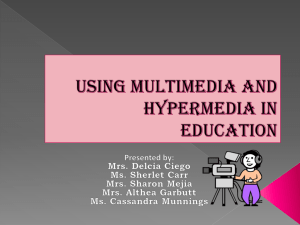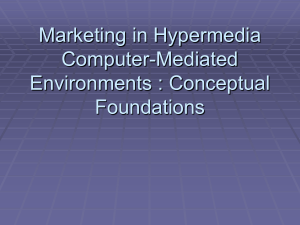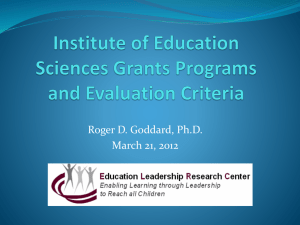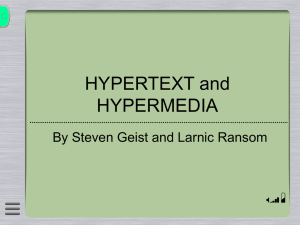Grant Writing Presentation for Development and Innovation Projects
advertisement
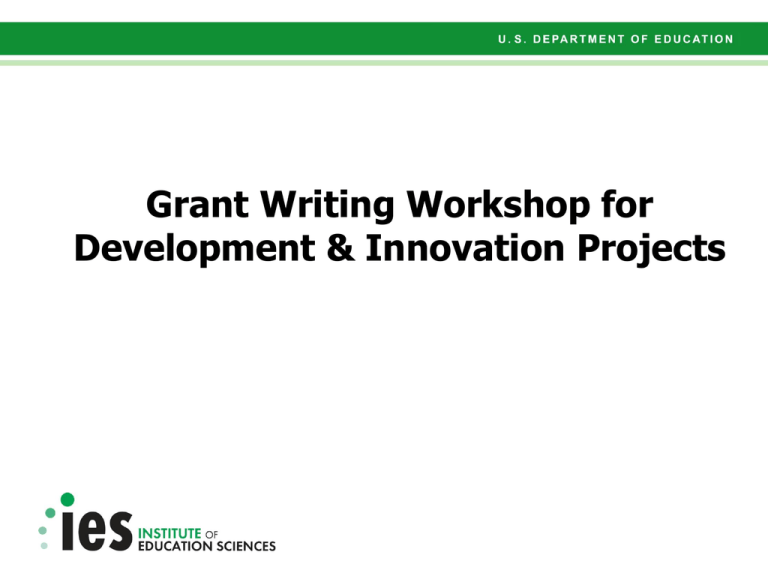
Grant Writing Workshop for Development & Innovation Projects Grant Research Goals • All applications to the Education Research Grants Program (84.305A) and the Special Education Research Grants Program (84.324A) must be directed to a specific research goal • The goal describes the type of research to be done The 5 Research Goals • Exploration – Explore the association between malleable factors and education outcomes • Development and Innovation – • Efficacy and Replication – • Evaluate an intervention under ideal conditions Scale-up Evaluation – • Develop a new or modify an existing intervention Independently evaluate an intervention under routine conditions Measurement – Develop and/or validate a measure Breaking Out of the Old Shell Development and Innovation Projects • Development of and innovation in education interventions – – – – – – Curricula Instructional approaches Supplemental (add-on) programs Professional development School-wide interventions District-level interventions Development and Innovation Projects • About 50% of NCER funded research projects • About 57% of NCSER funded research projects Development and Innovation Projects: Challenges • No widely accepted, systematic process for developing interventions • Education interventions cover a wide range in scope • Disciplinary differences in approaches Development Projects: Key Question • Why is the proposed intervention likely to produce better student outcomes relative to current education practices? Before Development Work Begins... Ask: Do I understand the problem? • • • Can I explain the underlying processes? Do I know what malleable factors might be targets for intervention? Do I know what distinguishes effective and less effective practices? In a Nut Shell... Development work depends upon prior research that explores and identifies underlying processes and potentially malleable factors. This knowledge is then used to inform the development of new interventions. FY 2012 IES Development and Innovation Projects Include: • Well-specified theory of change for the intervention • Fully developed intervention • Pilot data on the feasibility of implementing the intervention • Pilot data on the promise of the intervention for generating desired outcomes All IES Research Applications include 4 Sections • • • • Significance Research Plan (Methodological Requirements) Personnel Resources Specific Requirements For Development and Innovation Applications Significance Answers the question, “Why develop this intervention?” 1. Context for the proposed intervention 2. Intervention, theory of change, and theoretical and empirical rationale 3. Practical importance 4. Rationale justifying the importance of the proposed research Significance 1. Context for the proposed intervention • • • • Describe attributes of existing practice Specify shortcomings of existing practice Clarify the problem Describe how much of a change the proposed intervention is intended to achieve Significance 2a. Intervention, • What are the components or features of the proposed intervention? • How do the features or components relate to each other? • Who will implement or use it? • How will it be used? Example: Teacher PD for PreK ELL Vocabulary Instruction • Content – Which words will be taught? What is the rationale for that decision? • Strategies for vocabulary instruction – What techniques? Rationale? • Delivery of information to teachers – What materials? What mode of instruction for teachers? Rationale? • Objective – What should teachers be able to do? – What should their students be able to do? Significance 2b. theory of change, • What is the causal chain of events that leads from the implementation of the intervention to the desired outcome? Simple Model of Change Professional Development Intervention Vocabulary Instruction Outcomes Simple Model of Change: Teacher PD for PreK ELL Vocabulary Instruction Vocabulary Professional Development Intervention Resources: how many sessions and when, content, mode, materials Vocabulary Instruction Activities: continuous assessment, using data, using strategies for teaching vocabulary Outcomes and Measures: attendance, use of online resources, teacher logs, interviews, surveys, knowledge acquisition Outcomes and Measures: observations, fidelity of implementation, changes in pedagogy Outcomes Outcomes and Measures: mastery vocabulary measures, standardized language measures Significance 2c. theoretical & empirical rationale • What are the theoretical and empirical justifications for the design and sequencing of the intervention components? – Literature review – Describe any prior published or unpublished work completed by your team that supports your development effort Significance 3. Practical importance • Describe why the fully developed intervention will have the potential to improve student outcomes in educationally meaningful increments • Describe why the proposed intervention is affordable for and easily implemented by authentic education delivery settings Significance 4. Rationale justifying the importance of the proposed research • Why is this project a good idea, and important to fund? Methodological requirements (Research Plan) • Clear description of development activities, so that reviewers will understand – What will be developed – How it will be developed – When the development will take place Methodological requirements (Research Plan) 1. 2. 3. 4. 5. Sample Iterative development process Feasibility of implementation Pilot study Measures Methodological requirements 1. Sample • Describe samples and settings that will be used to – iteratively develop the intervention, – assess the feasibility of implementation, and – assess the promise of the intervention in the pilot data Methodological requirements 2. Iterative Development Process • How “operating as intended” for the proposed intervention is defined; • What data will be collected to determine how the intervention (or component) is operating; • How will the data collected be used to revise the intervention; • What criteria will be used to determine if the intervention or component operates as intended. What Will be Developed Content/ Feature A B C Exists Partially Developed To be Developed X X X Operating as Intended • Define “operating as intended” • Describe data to be collected to determine how the intervention (component) is operating • Describe criteria to determine if intervention operates as intended – Correspondence with theory of change Operating as Intended • What data will be collected to determine how the intervention is operating? – Often involves collection of process data (e.g., observation of teacher implementing a lesson) – Feedback from users – Specify how data will be coded (i.e., what are you looking for?) • How will the data be used to revise the intervention, if needed? Operating as Intended Note on using experiments to determine if intervention/components operate as intended – Often used in Cognition and Technology projects (but not required) – Acceptable for use in other topics for the purpose of development Example: Teacher PD Video Clips • Select possible examples from videotapes of master teachers implementing strategies • Write accompanying text for clips • Teachers (similar to target audience) review prototype clips and text • Semi-structured interview for teacher reactions in key areas (e.g., clarity of main message; length of clip/text; organization of text and its relation to clip) • Content analysis of interview data to identify what needs refining • Continue to refine and assess until consistent responses for identifying main message and perception of user-friendly clips/text Example: Use of Hypermedia • Objective: gather data on factors that facilitate teacher use of hypermedia resources in context of teacher PD coaching Example: Teacher PD Video Clips • Gather data on factors that facilitate teacher use of hypermedia resources in context of PD program • Small field test of PD program with hypermedia • Track teachers’ use of hypermedia with software (e.g., what do they look at, how long, how often) • Periodic interviews to identify what facilitates or impedes clicking on a hypermedia resource recommended by coach • Observations of teachers using hypermedia (amount of time spent on each clip/text, number of related clip/texts viewed) • Think-aloud sessions of teachers using hypermedia • Continue to refine and assess until consistent responses for teachers viewing suggested clip/text and usability of resources (e.g., ease of navigation) Iterations???? • Number of iterations depends on the complexity of the intervention and its implementation Methodological requirements 3. Feasibility of Intervention • Demonstrate that the intervention can be implemented with fidelity – In settings that represent the type of settings for which the intervention is intended – By users who are like those for whom the product is intended Methodological requirements 4. Pilot Study: Promise of the Intervention • Does performance on outcome measures progress in the appropriate direction? – Pilot study is stronger is a comparison group is used • Is implementation of intervention associated with changes in activities and behaviors that are consistent with the theory of change? Methodological requirements 5. Measures • Procedures for collecting data – Often includes collection of process data using observational, survey, or qualitative methodologies • Measures to be used, including reliability and validity information, where appropriate • A useful by-product of development is a set of fidelity of implementation measures Personnel • Relevant content expertise • Methodological expertise required for conducting the study • Experience working with schools or other education agencies Personnel • Include in the research narrative a brief description of the qualifications, roles, responsibilities, and percent of time to be devoted to the project for key personnel. Resources • Support at the research institution • Technological support • Letters of agreement from participating schools and/or teachers Appendix A • Page limit: 15 pages single-spaced • Include at end of the Project Narrative and submit as part of same PDF file attachment • Adhere to margin, format, and font size requirements Appendix A Include: • Figures, charts, or tables that supplement research text • Examples of measures to be used in the project • Resubmissions: use up to 3 pages to describe how revised proposal is responsive to prior reviewer feedback – indicate prior application number Appendix B • Page limit: 10 pages single-spaced • Include at end of Appendix A and submit as part of same PDF file attachment • Adhere to margin, format, and font size requirements Appendix B Include: • Curriculum materials • Computer screen shots • Test items you will develop • Other materials used in the intervention or assessment New This Year - Appendix C • Page limit: none • Include at end of Appendix B and submit as part of same PDF file attachment • Adhere to margin, format, and font size requirements Appendix C Include: • letters of agreement from research partners (e.g., schools, districts, consultants) • Do not reduce the size of the letters • Letters should clearly indicate understanding of time, space, and resources that will be required if the application is funded Additional Considerations—If Seeking A Second Development Award • If seeking to further develop or extend an intervention from a previous Development award, applicants should: – Justify the need for a second Development award – Describe the results and outcomes from other Development efforts – Describe efficacy evaluations and data (if available) Additional Considerations-If Seeking A Second Development Award • If a previous Development grantee wants to develop a new intervention, applicant should: – Indicate whether the first intervention has been evaluated for efficacy and describe results (if available) – Show that previous intervention improves or shows promise for improving education outcomes Notes for FY 2012 • No applications to develop reading interventions will be accepted under the Reading and Writing topic Award amounts • Typical award: $150,000 to $400,000 per year • Maximum of 3 years and $1,500,000 Review of Applications • No more than 30 percent of funds may be used to support the collection of pilot data • Review of methodological requirements will focus on methods for developing the intervention • Pilot data are not intended to be a test of the efficacy of the intervention Finding Requests for Applications FY 2012 Requests for Applications are available on: http://ies.ed.gov/funding Sign up for the IES Newsflash: http://ies.ed.gov/newsflash/ Key Dates Application Letter of Intent Deadline Due iesreview.ed.gov Application Package Available Start Dates www.grants.gov 6/23/11 4/21/11 4/21/11 3/1/12 to 9/1/12 9/22/11 7/21/11 7/21/11 7/1/12 to 9/1/12 Application Due Dates • Education and Special Education Research – June 23, 2011 and September 22, 2011 – 4:30:00 pm Washington, DC time Elizabeth Albro elizabeth.albro@ed.gov
